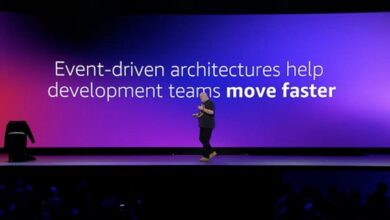The Challenges Telcos Face in Embracing Cloud-Native Architectures

For most businesses, designing and developing applications in the cloud is becoming a gold standard. According to one report, around 75% of companies are now putting a majority of their developer resources into creating cloud-native applications. Cloud-native architecture offers a more agile approach to development, leading to a significantly reduced time to market for new services and applications.
At a time when the window to seize new market opportunities is extremely narrow, and users expect new services – and improvements to existing ones – to be rolled out regularly, the time saved by working in the cloud is invaluable. Gartner estimates that, by 2025, more than 95% of development workloads will be deployed on cloud-native platforms – a dramatic increase from just 30% in 2021.
Before we explore the relationship between telcos and cloud-native architecture, let’s first touch on what cloud-native architecture actually means and why it’s proving so popular.
Cloud-native architecture refers to designing and deploying applications built in, and specifically for, cloud-based environments. Instead of relying on static, monolithic services to build and run applications, cloud-native architecture leverages microservices – small, independent modules that can be developed, deployed and scaled independent of one another. These services are run in containers, isolated runtime environments entirely self-sufficient, then linked through APIs to create a cohesive “whole.” This results in a modular approach to development, where individual services can be scaled, removed, swapped or upgraded with zero downtime and minimal impact on neighboring services. It is often referred to as “composable architecture” because containers are “composed” or “orchestrated” to work together in the delivery of new services.
If traditional monolithic architecture were a house, it would have to be torn down to add new structures or features. With cloud-native or composable architecture, businesses have the freedom to swap out individual bricks or add on new structures without affecting the overall integrity of the building. As Gartner puts it, “Composable business means creating an organization made from interchangeable building blocks.”
Obstacles to cloud-native architecture
Cloud-native offers businesses unparalleled agility in developing, deploying and scaling services – something that the telco industry stands to benefit from significantly. So what’s holding it back?
Legacy systems – a gilded cage for telcos?
In many cases, dependence on legacy systems has become so entrenched that they represent a gilded cage for telcos. When these legacy systems were deployed, they no doubt seemed like the perfect solution, but as the market has changed, those monolithic systems still need to keep up. The result is a “Frankenstein” architecture – a delicate web of applications, databases and vendor dependencies that are difficult to unpick and replace without significant disruption.
This gilded cage is the very scenario that cloud-native architecture seeks to avoid, but getting from one to the other is far more than a “lift and shift” operation. It demands a comprehensive understanding of the existing architecture, followed by a meticulous decoupling, reengineering and re-architecting process.
For telcos, this challenge is magnified due to the critical nature of their services. Any disruption can have wide-reaching consequences, affecting millions of users. Furthermore, telcos often operate under stringent regulatory and compliance requirements, making any system overhaul risky. The migration process might involve data migration, application refactoring, rewriting code and even retraining staff to manage and operate under the new cloud-native environment. Additionally, legacy systems often come with long-standing vendor contracts, proprietary technologies and specialized hardware, further complicating the transition.
The sheer scale and complexity of these systems, combined with the need to maintain service continuity, make the move to cloud-native a daunting task for telcos. However, with a well-planned strategy, the right expertise and a phased approach, this transition can be managed effectively, paving the way for a more agile and resilient future. The benefits of this future far outweigh any short-term risk, but that risk must be mitigated nonetheless.
Rising security concerns
Security remains a primary concern for telcos, especially given the sensitive nature of the data they handle and the criticality of the services they provide. The public cloud, while offering robust security features, presents a new landscape of potential vulnerabilities and threats. More than most businesses, telcos must grapple with questions about data sovereignty, ensuring that user data remains within jurisdictional boundaries and adhering to strict compliance and regulatory standards.
The transition to the cloud also introduces complexities around multi-tenancy, where resources are shared among multiple business users. Ensuring data isolation in such an environment becomes crucial. Additionally, the dynamic nature of cloud environments, with resources being provisioned and decommissioned on the fly, necessitates continuous monitoring and real-time threat detection mechanisms.
Integrating legacy security protocols with modern cloud security practices is also a concern. For instance, legacy systems might have been designed with perimeter-based security models, focusing on strong boundary defenses. In contrast, cloud-native security emphasizes a zero-trust model, where every access request is verified, authenticated and validated, regardless of origin.
For telcos, navigating this new security landscape requires a paradigm shift. It’s about implementing new security tools and fostering a culture of security awareness, continuous learning and adaptation. Collaborating with cloud providers, leveraging their security expertise and adopting best practices can help telcos ensure a secure path to a cloud-native environment.
The sunk cost fallacy
Legacy systems, having been in place for decades, represent a substantial “sunk cost” in terms of infrastructure, licensing and specialized hardware. Moving away from these systems means that telcos might have to write off these investments, leading to potential short-term financial setbacks. Moreover, the initial stages of the transition to cloud-native can be financially challenging. It involves setting up new cloud environments, procuring necessary tools and services and possibly paying for dual operations, as both legacy and cloud systems run in parallel during the migration phase. This dual operation doubles the operational costs and requires additional resources for synchronization, data integrity checks and ensuring service continuity – a crucial factor for telcos.
Furthermore, there are the costs and time associated with cloud training and upskilling the existing workforce. Cloud-native operations demand a different skill set, and telcos will need to invest heavily in training programs and workshops to make the most of the transition.
Nevertheless, viewing these costs in the context of long-term ROI is essential. While the initial investment might be high, cloud-native architecture offers operational efficiencies, scalability and agility that can lead to substantial savings and revenue opportunities in the long run. For telcos, the challenge lies in striking a balance, ensuring that the transition is financially viable and strategically beneficial.
The need for a defined roadmap
For many telcos, the journey to cloud-native may feel like navigating uncharted waters. The absence of a clear roadmap and the myriad challenges of legacy systems, security concerns and financial implications can make the path forward seem daunting. However, it’s important to note that these waters are charted, and with the right level of strategic planning, application rationalization and a phased approach to implementation, cloud-native becomes more than just viable – it becomes optimal.
First, telcos must define their end goals. What does a successful cloud-native operation look like for them? This vision will serve as the “north star,” guiding all subsequent decisions. Once the destination is clear, telcos can work backward, identifying the milestones and interim goals that will lead them there.
This approach ensures that they never lose sight of the bigger picture even when tackling the immediate challenges. By partnering with the right cloud providers, industry experts and technology vendors, telcos have a much better chance of avoiding some of the risks and pitfalls mentioned above and accelerating their journey to the cloud.
Adaptability and resilience will be key — the cloud-native journey is not a linear one, and setbacks are all but guaranteed. Viewing these setbacks as learning opportunities instead of writing them off as failures is the hallmark of a successful transition. While the path to cloud-native might be complex, it’s a journey worth undertaking.
The benefits of agility, scalability and operational efficiency await those who persevere. For telcos, the future is cloud-native, and with a clear vision, strategic partnerships and an adaptable approach, they can confidently stride into this new era ready to harness the technology’s full potential.




